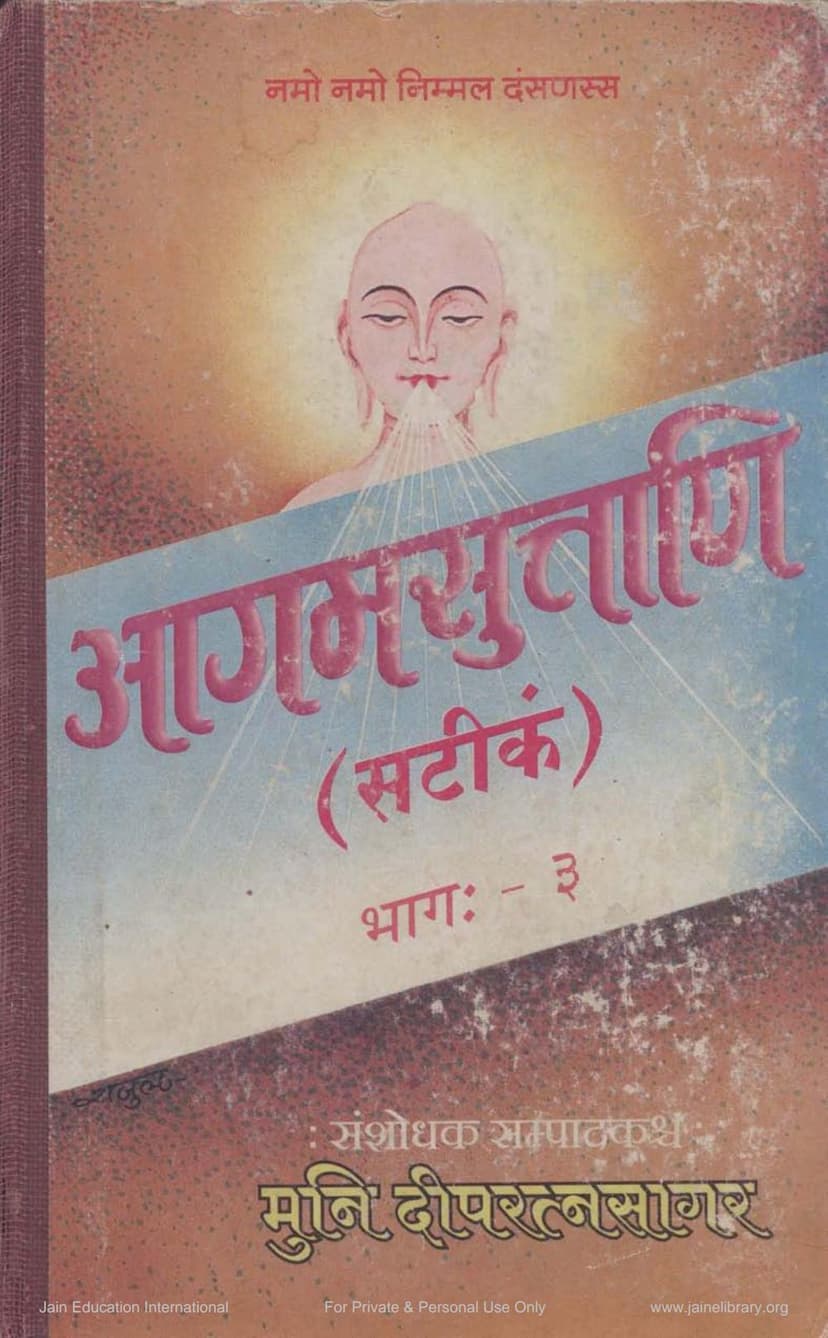Agam Sutra Satik 03 Sthan AngSutra 03
Added to library: September 1, 2025

Summary
This is a comprehensive summary of the Jain text "Agam Sutra Satik 03 Sthan AngSutra 03", based on the provided catalog link and pages from the text.
Book Title: Agam Sutra Satik 03 Sthan AngSutra 03 Author(s): Dipratnasagar, Deepratnasagar Publisher: Agam Shrut Prakashan
This work is a commentary (Satik) on the Sthananga Sutra, which is the third Anga (section) of the Agam Sutras in Jainism. The text was researched and edited by Muni Deepratnasagar.
Core Subject: The Sthananga Sutra, as presented in this volume, is a foundational text in Jain philosophy. Its primary objective is to categorize and explain all Jain principles, concepts, and phenomena based on their "places" or "locations" (Sthana). These places represent numerical categories, typically from one to ten, or classifications based on various aspects of Jain doctrine.
Structure and Content:
The provided text is extensive and appears to cover the first Anga of the Sthananga Sutra in detail, focusing on its commentary. Based on the table of contents and snippets of the text, the book likely covers the following:
- Comprehensive Classification: The Sthananga Sutra is known for its systematic enumeration and classification of Jain teachings. This volume likely follows that structure, exploring various topics by placing them within numerical categories.
- Ten Places (Dasa Sthana): The Sthananga Sutra is structured around ten "places" or "categories." The book delves into each of these, likely exploring:
- Sthana 1 (First Place): This appears to cover foundational concepts like the nature of the soul (Atma), the instruments of action (Karma), the cosmology (Lokāloka), the principles of movement (Gati), the classification of souls (Jiva), the non-soul elements (Ajiva), and various other fundamental dualities and classifications. The introduction (Upo-dghātah) likely sets the stage by explaining the importance of the text, its author (Ganadhar Sudharma Swami), and the methodology of its study.
- Subsequent Sthanas (Sthana 2 to Sthana 10): Each subsequent sthana would then delve into further classifications and details of Jain philosophy. For example, Sthana 2 seems to deal with the characteristics of beings based on their places, such as duality (Jiva vs. Ajiva, Narak vs. Deva), states of existence, types of actions, and different classifications of entities like hell-dwellers, celestial beings, and embodied souls. It also seems to touch upon various aspects of karma, senses, mind, speech, and body.
- Detailed Topics: The table of contents suggests a vast range of topics covered, including:
- Soul and Matter: Discussions on Jiva (soul) and Pudgala (matter).
- Cosmology: Descriptions of the universe, lokāloka, directions, and different realms of existence (heaven, hell).
- Principles of Jainism: Discussions on Dharma (righteousness/principle of motion), Adharma (unrighteousness/principle of rest), Akasha (space), Kala (time), and Bandha (bondage), Moksha (liberation).
- Karma and Liberation: The nature of karma, its influx (Ashrava), its stoppage (Samvara), its shedding (Nirjara), and the ultimate goal of liberation (Moksha).
- Knowledge and Perception: Different types of knowledge (Jnana) and perception (Darshana).
- Conduct and Ethics: Discussions on vows (Vrata), disciplines, and the conduct of monks and nuns.
- Metaphysics and Ontology: Concepts like categories of existence, enumeration of entities, and their various attributes.
- Jain Canon: References to various Angas and their contents.
- Biographies and Narratives: Potentially includes descriptions of Tirthankaras, Gandharas, and other significant figures.
- Numerical Classifications: A recurring theme is the classification of phenomena into categories like one, two, three, four, five, six, etc., to explain the diversity within Jain principles.
- Commentary Style: The presence of "Satik" in the title indicates that this is not just the original sutra but also includes a detailed commentary, likely by Acharya Abhaydev Suri, as mentioned on page 8. This commentary would explain the intricate meanings, linguistic nuances, and philosophical implications of the sutras.
- Numerical Categories: The text is rich in classifying phenomena based on numbers. For instance, it details "five senses," "six kinds of existence," "ten places," and so on, providing a systematic framework for understanding Jainism.
Significance:
The Sthananga Sutra is considered one of the most important Agamas as it provides a comprehensive index and analysis of all Jain doctrines. This commentary by Muni Deepratnasagar would make the complex and vast teachings of the Sthananga Sutra accessible to scholars and practitioners, facilitating a deeper understanding of Jain philosophy and practice. The book serves as a crucial resource for Jain education, offering a structured approach to learning the entire corpus of Jain literature.
Overall Impression:
The text appears to be a scholarly and thorough presentation of the Sthananga Sutra, aimed at preserving and disseminating the detailed classifications and philosophical insights of Jainism. The commentary plays a vital role in elucidating these concepts. The extensive nature of the work suggests a dedication to providing a complete and authoritative resource for Jain studies.